

To better understand the city of Warsaw, and Poland itself, I suggest to have a look at the history. It is rich, fascinating, and too often very tragic. Whether doing a deep dive or having a high-level overview, to have an understanding of the past is to have an understanding of the present. For those who do not have the time to read lengthy history books, I am including a shortened version of Warsaw's history. I have tried to break it up into time periods, which in my view left a visible imprint on the city. Please note that as the website in under "re-construction", I am continually updating all sections.
The Legend:
Many cities have legends about their foundation. Rome has Romulus and Remus, Warsaw has Wars and Sawa. There are several versions of the legend....
The Beginnings:
Although almost 700 years old, Warsaw is considered to be a young city by Polish standards. Warsaw was only starting to emerge as a city from the
Mazovian forest, when cities such as: Krakow, Gdansk, Wroclaw or Kalisz were celebrating their quincentenaries.
First traces of settlement in the Warsaw area date from the 10th century. The first notable structure does not come in until the beginning of the
14th century, when the dukes of Mazovia built a stronghold on the site where the Royal Palace stands today, thus starting a township. The city's outlay closely
followed that of many other medieval Polish towns: central square with a nearby church and the whole town surrounded by fortified walls for protection.
In 1413 Warsaw became the seat of the Mazovian dukes, and the city experiences a wave of development. At about this period we see the emergence of
the New Town along the northern walls of the Old Town.
In 1526 the last duke of Mazovia died without an heir, thus putting Warsaw along with the whole of Mazovia under the direct rule of the Polish king in
Krakow.
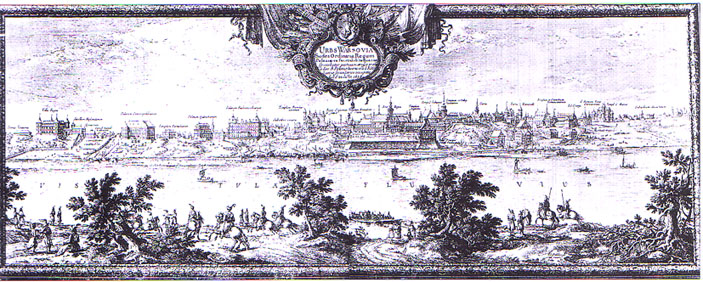
A view of Warsaw from the right bank of the Vistula (circa 1656).
Warsaw - The Capital of Poland:
In 1569 Warsaw became the seat of the Sejm (Polish parliament), due to its central location in the new union between Poland and Lithuania. Four years
later the city became the seat of the royal elections, however the King still resided in Krakow.
In 1596 Warsaw became the capital after a fire in the King Zygmunt III Waza's residence in Krakow. During the 1655-1660 Swedish invasion of Poland,
Warsaw suffered heavy damage this included physical and cultural losses.
The 18th century saw some of the most splendid growth of the city. It was during this period that many of the palaces, churches and monasteries were
erected and the cultural life flourished, especially during the reign of the last Polish king Stanislaw August Poniatowski.
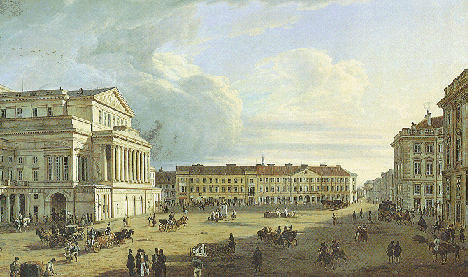 |
 |
|
The Grand theater (Teatr Wielki) in Warsaw around the early 19th century.
|
A 16th century depiction of
Warsaw.
|
Partitions of Poland:
The first partition of Poland took place in 1772 and by 1795 Poland had been totally partitioned between three major European empires: Prussia, Russia and the Habsburgs. Taking advantage of weak state of Poland caused by ..... Warsaw found itself under the Prussian rule and its role was diminished to that of a small provincial town. However in 1807 Warsaw became the capital when Napoleon created the Duchy of Warsaw. With the collapse of Napoleonic France in 1830, however, Warsaw fell to the Russian rule. Despite the occupation by the Russian empire, Warsaw continued in its steady development along with a steady population increase. By 1900 Warsaw had 700,000 inhabitants.
Polish Independence and the Interwar Period (1918 - 1939):
Following the end of Word War I and as a result of the Treaty of Versailles, Poland regained her independence in 1918. Warsaw became the capital of the Second Polish Republic (Druga Rzeczpospolita). Between the wars a deliberate development of the city was undertaken.
World War II and the German occupation (1939 - 1945):
Already in 1939 the population of Warsaw had risen to over 1.3 million. When World War II broke out in 1939 the capital heroically defended itself until the 27th of September, 1939. During the five years of German occupation that followed the city's population lived in terror.
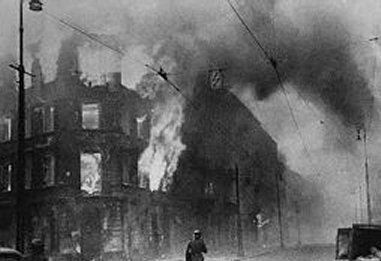
The Warsaw Ghetto is burned down.
The Jewish citizens were forced to live in a walled-in ghetto. From there they were sent to the gas chambers of Oswiecim (Auschwitz) and other
death camps. When the Germans decided to clear the Warsaw ghetto in the spring of 1943 the Jews resisted the Germans in an armed battle rather than to give up
without a fight. In an unequal battle than ensued thousands of Jewish fighters and civilians were brutally wiped out. Intellectuals were also persecuted.
Virtually everyone was in constant danger of being arrested in a round up and getting sent to work or to a concentration camp.
On the 1st of August, 1944 at 17:00 hour (Godzina W) the Warsaw Uprising broke out. From the beginning the resistance fighters of the Home Army (Armia Krajowa) were faced with an unequal battle. The Soviet army which had been relentlessly pushing the German Wehrmacht across the Eastern European plains in the summer of 1944, suddenly paused on the eastern bank of the Vistula river. The Soviets who just a few weeks earlier were enthusiastically encouraging an armed resistance to the Germans, were now silently sitting on the other side of the Vistula river with a view of burning Warswa. After 63 days of heroic resistance the Warsaw uprising was brutally suppressed. This was the largest act of rebellion in Nazi-occupied Europe and certainly contributed to a quicker end of the war. However, the human costs were steep. Over 200,000 of Warsaw's civilian inhabitants and Home Army soldiers were dead. The debate about the necessity of the uprising continues to this day. After the suppression of the uprising all the inhabitants were expelled from the city and many being taken to concentration camps. On Hitler's personal orders, the Germans systematically burned down and blew up the remaining buildings including many of great significant historical and cultural value. This was done in an effort to erase Warsaw from the face of the planet for eternity. By October 1944, Warsaw was no more.
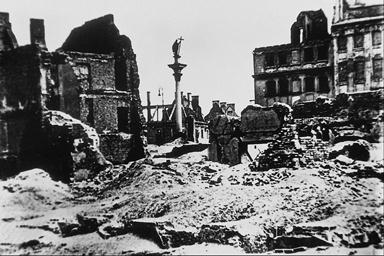 |
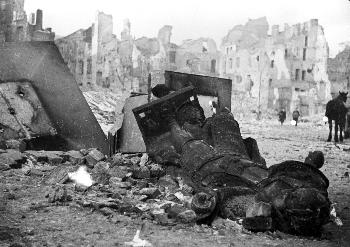 |
|
The aftermath of the Warsaw Uprising in October, 1944. The Old Town lays in ruins.
|
The statue of King Zygmunt after the column supporting it was blown up following the end of the Warsaw Uprising.
|
Post-War Years, the Socialist Utopia and the Iron Curtain (1945 to 1989):
Warsaw, or what was left of it, was finally liberated on the January 17, 1945. When the Red Army and its Polish divisions entered the city. The term liberated ... altogether 800,000 of its inhabitants had perished during the war. The survivors came back to their city almost immediately and started to rebuild it. Warsaw again became the capital of Poland. But once more its fate was really determined by Moscow, a fact symbolized by the Palace of Culture (originally named in honor of Joseph Stalin) towering over the city center since 1955. In 1981 the communist rulers had to rely on the army to defend their power against the Solidarity movement of Lech Walesa, announcing martial law on 13th of December. With the crumbling economy and the transformations going on in the Soviet Union, the communists finally had to allow free elections in 1989. These ended in a complete defeat for the Communist Party. Right away the new government began extensive democratic and economic reforms. For Warsaw a great economic boom began. Many foreign and domestic companies decided to make Warsaw their principle place of business. This brought many new changes to the city including many new buildings, a more hectic life-style, and an ever increasing population. With 1.7 million inhabitants Warsaw is trying to catch up with the western capitals. Despite many problems the city is growing. Every year the face of the city changes in a dramatic and surprising way. The city has also opened up to tourists whom it hopes to attract in large numbers. Most importantly the city is again free after decades of unwelcome foreign rule and influence.
1989 to 2004:
Warsaw....................................................................
2004 to Present:
Warsaw.